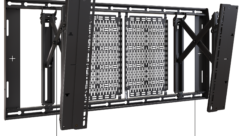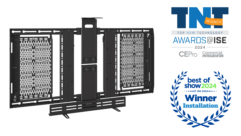
Efficiency at Middle Atlantic
Aug 23, 2010 12:00 PM,
By Cynthia Wisehart
By now, you know I like factory tours and rack rooms. Especially when I get to see American-made enterprise and ingenuity at work, whether in a systems or manufacturing setting. With all due respect to the great work done globally, there is something compelling about standing in a local facility or factory where people are doing important and productive work.
This month, I got to see the new and nearly completed Los Angeles Emergency Operations Center, an adventure that merits future discussion for the way its systems, architecture, and purpose converge on the goal of protecting human life—in this case, my own and that of my family here in the fire-prone foothills of the Angeles Crest.
Middle Atlantic‘s facility in Riverdale, N.J., is another long-standing local success story, one that fittingly celebrates the contribution of its workers from all over the globe. The cafeteria walls are hung with some 30 flags from the home countries of Middle Atlantic employees, and the building still carries the vibe of its history in airline manufacturing.
I was immediately struck by something that Middle Atlantic does not overtly market. The factory is remarkably clean—not just cosmetically, but in terms of sustainability practices. The air is clean; the noise is relatively mitigated; and the processes are designed to minimize waste of materials, chemical outgassing, and thermal management.
I learned that it is ISO 14000-certified, but that seemed likely just from walking around. There are also efficiency examples throughout the factory that this is a business that was built by a chief engineer, who is also founder and president: Bob Schluter. On the floor are a great many examples of Schluter’s own work to re-engineer and improve manufacturing equipment and practices.
The visit helped explain Middle Atlantic’s approach to product development. In addition to working with its customers as all good companies in our industry do, it seems to be building products the way company leaders would want them to be if they themselves were using them. It was interesting to see a certain relationship between the environment at the factory and the products that are made there. Kind of a unified philosophy. And heartening.
Also heartening this month were my talks with representatives from Extron, Crestron, and AMX for our cover story. Each of them took a lot of time to discuss the immediate and driving issue that is going on in AV control—and by extension, in the entire industry.
I cannot report that they have solved anything, because there is much to be solved as AV systems come together with other facility systems—especially IT. There is much that remains unknown, and all these companies readily acknowledged that they see us at the beginning of a new paradigm. It’s one we are equipped for. AV professionals can be proud of their expertise in one of the most difficult installation disciplines. But they also cannot rest on the past.
We’ve never had the luxury of being a pampered industry. We’ve always had to go back to the drawing board and compete in what can feel like a three-dimensional jigsaw puzzle. Now, as AV systems become not just luxuries but necessities, we will have to compete again. Feel free to keep making demands on your control manufacturers to help you do that.










